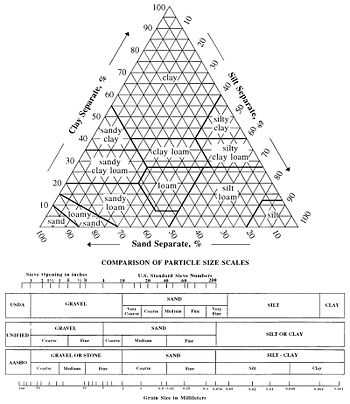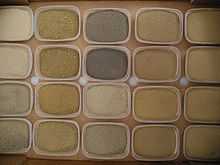Soil classification
Soil classification deals with the systematic categorization of soils based on distinguishing characteristics as well as criteria that dictate choices in use.
Overview
Soil classification is a dynamic subject, from the structure of the system itself, to the definitions of classes, and finally in the application in the field. Soil classification can be approached from the perspective of soil as a material and soil as a resource.
Engineering
Engineers, typically geotechnical engineers, classify soils according to their engineering properties as they relate to use for foundation support or building material. Modern engineering classification systems are designed to allow an easy transition from field observations to basic predictions of soil engineering properties and behaviors.
The most common engineering classification system for soils in North America is the Unified Soil Classification System (USCS). The USCS has three major classification groups: (1) coarse-grained soils (e.g. sands and gravels); (2) fine-grained soils (e.g. silts and clays); and (3) highly organic soils (referred to as "peat"). The USCS further subdivides the three major soil classes for clarification.
Other engineering soil classification systems in the States include the AASHTO Soil Classification System and the Modified Burmister (See biographical sketch of Prof. Donald Burmister ).
A full geotechnical engineering soil description will also include other properties of the soil including color, in-situ moisture content, in-situ strength, and somewhat more detail about the material properties of the soil than is provided by the USCS code.
Soil science

For soil resources, experience has shown that a natural system approach to classification, i.e. grouping soils by their intrinsic property (soil morphology), behaviour, or genesis, results in classes that can be interpreted for many diverse uses. Differing concepts of pedogenesis, and differences in the significance of morphological features to various land uses can affect the classification approach. Despite these differences, in a well-constructed system, classification criteria group similar concepts so that interpretations do not vary widely. This is in contrast to a technical system approach to soil classification, where soils are grouped according to their fitness for a specific use and their edaphic characteristics.
Natural system approaches to soil classification, such as the French Soil Reference System (Référentiel pédologique français) are based on presumed soil genesis. Systems have developed, such as USDA soil taxonomy and the World Reference Base for Soil Resources, which use taxonomic criteria involving soil morphology and laboratory tests to inform and refine hierarchical classes.
Another approach is numerical classification, also called ordination, where soil individuals are grouped by multivariate statistical methods such as cluster analysis. This produces natural groupings without requiring any inference about soil genesis.
In soil survey, as practiced in the United States, soil classification usually means criteria based on soil morphology in addition to characteristics developed during soil formation. Criteria are designed to guide choices in land use and soil management. As indicated, this is a hierarchical system that is a hybrid of both natural and objective criteria. USDA soil taxonomy provides the core criteria for differentiating soil map units. This is a substantial revision of the 1938 USDA soil taxonomy which was a strictly natural system. Soil taxonomy based soil map units are additionally sorted into classes based on technical classification systems. Land Capability Classes, hydric soil, and prime farmland are some examples.
In addition to scientific soil classification systems, there are also vernacular soil classification systems. Folk taxonomies have been used for millennia, while scientifically based systems are relatively recent developments.[1]
Soil Classifications for OSHA
The US Occupational Safety and Health Administration (OSHA) requires the classification of soils to protect workers from injury when working in excavations and trenches. OSHA uses 5 soil classifications:
Stable Rock
Type A - cohesive, plastic soils with unconfined compressive strength greater than 1.5 ton/sf
Type B - cohesive soils with unconfined comressive strength between 0.5 and 1.5 ton/sf
Type C - granular or cohesive soils with unconfined compressive strength less than 0.5 ton.sf
Type C60 -
Each of the soil classifications has implications for the way the excavation must be made or the protections (shoring, shielding, etc.) that must be provided to protect workers from collapse of the excavated bank. see also - http://www.osha.gov/dts/sltc/methods/validated/id194/id194.html http://www.osha.gov/pls/oshaweb/owadisp.show_document?p_table=STANDARDS&p_id=10932
This section needs help, define C60 soils with reference. Believed to be Type C soils with groundwater present.
See also
- AASHTO Soil Classification System
- Australian Soil Classification
- Canadian system of soil classification
- French soil classification
- FAO soil classification
- International Committee on Anthropogenic Soils (ICOMANTH)
- Soil science
- Soil texture classification
- Soil value
- USDA soil taxonomy
- World Reference Base for Soil Resources (WRB)
Notes and references
- ↑ Soil classification systems. Url last accessed 2006-04-18
Further reading
- Eswaran, H., Rice, T., Ahrens, R., & Stewart, B. A. (Eds.). (2002). Soil classification : a global desk reference. Boca Raton, Fla.: CRC Press.
Current international system
- Buol, S.W., Southard, R.J., Graham, R.C., and McDaniel, P.A. (2003). Soil Genesis and Classification, 5th Edition. Iowa State Press - Blackwell, Ames, IA.
- Driessen, P., Deckers, J., Spaargaren, O., & Nachtergaele, F. (Eds.). (2001). Lecture notes on the major soils of the world. Rome: FAO.
- FAO. (1998). World Reference Base for Soil Resources. Rome: Food and Agriculture Organization of the United Nations.
Current national systems
- Agriculture Canada Expert Committee on Soil Survey. (1987). The Canadian system of soil classification (2nd ed.). Ottawa: Canadian Government Publishing Centre.
- Avery, B. W. (1980). Soil classification for England and Wales: higher categories. Cranfield, England: Cranfield University, Soil Survey & Land Research Centre/National Soil Resources Institute.[1]
- Baize, D., & Girard, M. C. (Eds.). (1995). Référentiel pédologique 1995. Paris: Institut National de la Recherche Agronomique.
- Baize, D., & Girard, M. C. (Eds.). (1998). A sound reference base for soils: The "Référentiel Pédologique" (English translation by Hodgson J.M., Eskenazi N.R., & Baize D. ed.). Paris: Institut National de la Recherche Agronomique.
- Hewitt, A. E. (1992). Soil classification in New Zealand: legacy and lessons. Australian Journal of Soil Research, 30, 843-854.
- Isbell, R. F. (1996). The Australian soil classification. Collingwood, Victoria, Australia: CSIRO.
- Soil Classification Working Group. (1991). Soil classification: a taxonomic system for South Africa. Pretoria: Department of Agricultural Development, RSA.
- Soil Survey Staff. (1999). Soil taxonomy: a basic system of soil classification for making and interpreting soil surveys (2nd ed.). Washington, DC: US Department of Agriculture Soil Conservation Service.
Current technical systems
Technical soil classification systems focus on representing some specific facet or quality of the soil, rather than a direct pedogenetic classification. Such technical classifications are developed with specific applications in mind, such as soil-water relationships, land quality assessment or geotechnical engineering.
- Boorman, D. B., Hollis, J. M., & Lilly, A. (1995). Hydrology of soil types: a hydrologically-based classification of the soils of the United Kingdom (No. 126): UK Institute of Hydrology.[2]
- Klingebiel, A. A., & Montgomery, P. H. (1961). Land capability classification. Washington, DC: US Government Printing Office.
- Sanchez, P. A., Palm, C. A., & Buol, S. W. (2003). Fertility capability soil classification: a tool to help assess soil quality in the tropics. Geoderma, 114(3-4), 157-185.
- American Society for Testing and Materials, 1985, D 2487-83, Classification of Soils for Engineering Purposes: Annual Book of ASTM Standards. Vol. 04.08, pp 395–408.
Earlier systems of historical interest
- Baldwin, M., Kellogg, C. E., & Thorp, J. (1938). Soil classification. In Soils and men: Yearbook of agriculture (pp. 979–1001). Washington, DC: U.S. Department of Agriculture.
- Simonson, R. W. (1989). Historical aspects of soil survey and soil classification with emphasis on the United States, 1899-1970. Wageningen, NL: International Soil Reference and Information Centre (ISRIC).
Principles
- Butler, B. E. (1980). Soil classification for soil survey. Oxford: Oxford Science Publications.Science, 96,
- Cline, M. G. (1949). Basic principles of soil classification. Soil Science, 67(2), 81-91.
- Cline, M. G. (1963). Logic of the new system of soil classification. Soil 17-22.
- Webster, R. (1968). Fundamental objections to the 7th approximation. Journal of Soil Science, 19, 354-366.
- Terzaghi Karl (1924). Soil Mechanics in Engineering Practice, Wiley-Interscience; 3 Sub-edition (January 1996, ISBN 0-471-08658-4)
Numerical classification
- McBratney, A. B., & de Gruijter, J. J. (1992). A continuum approach to soil classification by modified fuzzy k-means with extragrades. Journal of Soil Science, 43(1), 159-175.
References
- ↑ "Soil classification system of England and Wales". Cranfield University, National Soil Resources Institute. Retrieved 2011-12-22.
- ↑ "Hydrology of soil types". Cranfield University, National Soil Resources Institute. Retrieved 2011-12-22.
External links
- A Compendium of On-Line Soil Survey Information - Soil Classification for Soil Survey by D. G. Rossiter
- Engineering soil description and classification
- OSHA Soil Classification
| ||||||||||||||||||||||||||||||||||||||
